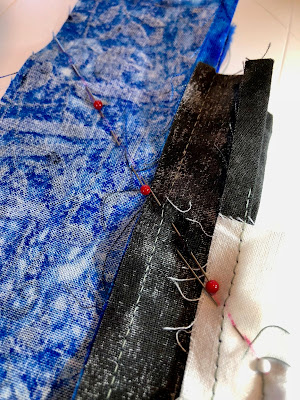I've been making progress on one of my three quilts for our guild's challenge show. That's really a good thing, because they need to be turned in next week!
Here is a cloud in my blue patchwork sky. I machine felted regular batting onto a sheer white fabric. Then I tacked the fabric onto the quilt. That saved me from the uncertainty of how the felting action would affect the background, if at all.
And this is a shrub. A real close close-up of a shrub. I started by laying down some random fibers that I had collected from my dryer's lint trap after washing new fabric. Then I embroidered feather stitches over the top in a very random way. I repeated the embroidery with different colors.
And I'm quite proud of this! It is a brick sidewalk, and I think it turned out pretty well, for someone who isn't an expert in free motion quilting! I checked Pinterest for "free motion quilting bricks" and whose name should come up but Lori Kennedy! She's a queen in my eyes, of free motion quilting. I followed her great directions for bricks, did a practice piece, then went to work on my little sidewalk. I used a chalk marker to make the parallel (and in some cases slanted) lines, to keep my bricks fairly even.
This is maybe more detail (and quite different lighting!) than is really needed, but I thought I'd include some more photos of the bricks.
After the challenge show opens next week, I'll show you the finished photo of this quilt, and my other two quilts, too.



















